Picture this: You’ve just finished a long day, and all you want to do is collapse on the couch. But as you walk through your door, an all-too-familiar scent hits your nostrils—your cat pees on a dog bed, again.
This perplexing behavior, where your fluffy feline targets their canine sibling’s snooze spot for such an unsavory act, is a puzzle many pet owners face.
Understanding the “whys” behind this behavior is crucial for any cat and dog owner who wants to restore peace and cleanliness to their home.
One solution may be ensuring your cat has two clean litter boxes available, as many cats prefer separate boxes for urination and defecation.
Another solution could be replacing the dog bed with one made of different materials.
Sometimes, materials like plastic bags, which attract cats, might make the dog bed seem like a more pleasant spot for cat urine.
Additionally, using an enzymatic cleaner or vinegar solution with baking soda can help eliminate any lingering odors from urine stains.
After soaking the stain with the vinegar solution, sprinkle baking soda over the area and let it dry before vacuuming it up. This will not only remove the odor but also help absorb any remaining moisture.
However, it is important to avoid using bleach as it contains ammonia, which can attract cats to mark in the same spot again.
Instead, opt for a pet-safe cleaner specifically designed to remove urine stains and odors.
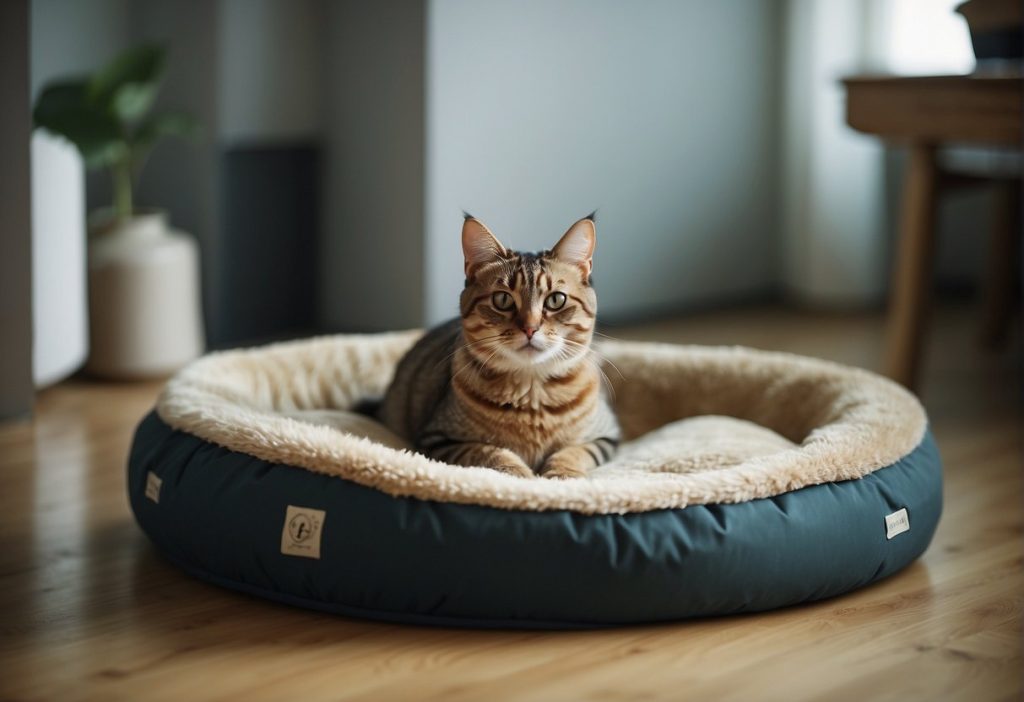
Don’t worry, you’re not alone in this stinky situation. Many pet owners face the conundrum of cats peeing on dog beds, and while it can be a messy and frustrating issue, there’s good news: it’s solvable!
Together, we’ll unpack reasons for this behavior, ranging from marking territory to medical conditions such as bladder stones, and lay out actionable strategies to ensure your pets live together harmoniously, even after a sudden change in their environment.
So let’s get started on this journey to a cleaner, happier multi-pet household, including male cats.
The first thing to do is to understand why your cat is peeing on the dog bed, which may include medical conditions such as UTIs or the deposition of small amounts of urine on the bed, which is a common behavior in cats.
The only way to treat this is to visit your vet for proper diagnosis and treatment.
Key Takeaways
- Cats may urinate on dog beds due to behavioral or medical issues.
- Understanding these motivations is key to addressing and correcting the behavior.
- Solutions include environmental changes, medical interventions, and fostering positive pet relationships.
Understanding Cat and Dog Interactions
Cats are intriguing creatures, especially when it comes to how they interact with their canine housemates.
Territorial Tactics
Cats are known to be territorial, and your home is no exception to their rule! They view the entire space as theirs and might view your dog’s bed as prime property.
- Dominance Dynamics:
Sometimes, a cat peeing on the dog bed is akin to planting a flag on a mountaintop—it’s a statement of “I’m in charge here!”
Perceiving the Pooch
Cats are solitary hunters and are hardwired to control their environment, which includes your unsuspecting dog. A dog’s bed can be like a new frontier for your feline friend aiming to assert their dominance.
Signs of Stress
Cats under stress may show:
- Changes in eating habits
- Uncharacteristic aggression
- Excessive grooming
Let’s consider a case study in multi-pet households. When a new pet is introduced, it’s common for the resident cat to feel unsettled.
This can manifest in various behaviors, from swatting at the new dog to commandeering their sleeping spot.
Hey there, have you noticed your cat:
- Hissing more than a deflated balloon?
- Clinging to you like a burr on a wool sock?
These can be telltale signs that your kitty is feeling the pressure of sharing their kingdom with a dog.
Remember, it’s not just about coexistence; it’s about understanding the nuanced language of fur, paws, and claws. By tuning into these subtleties, you can ensure peace in your pet-filled paradise.
In-Depth Causes of Cat Pees on Dog Bed
Medical Reasons Behind Inappropriate Urination
Have you ever wondered why your feline friend might snub their litter box and opt for the dog’s bed instead?
Well, medical issues, such as UTIs, diabetes, and kidney troubles, could be the sneaky culprits behind your cat’s behavior.
Let’s talk numbers: Urinary tract infections (UTIs), for instance, might be the reason behind nearly 10% of cats’ elimination problems. (1)
And don’t get us started on diabetes or kidney troubles, which can be a source of your cat’s negative associations with the litter box and result in inappropriate urination due to their instinct as clean animals.
If you suspect a health problem is causing your cat’s behavior, such as peeing on a dog bed, it’s important to consult with your veterinarian for a proper diagnosis and treatment plan.
Remember, your cat’s health should always be a top priority, so don’t hesitate to contact your veterinarian if you suspect a health issue is behind your cat’s behavior.
- Urinary Tract Infections: Bacteria barging in where they’re not wanted.
- Diabetes: Too much sugar in the bloodstream, causing frequent bathroom breaks. (2)
- Kidney Issues: When the kidneys stage a rebellion and litter-box habits falter. (3)
Remember, your vet is your detective in these cases, uncovering clues through tests. Early bird gets the worm or rather, early vet visits might save you from cleaning up one too many “accidents.” ()
Environmental and Social Factors
You’ve moved the couch, and Fluffy is flustered. Change is afoot, and it might just lead to Spot’s bed turning into a makeshift litter box.
You see, your furball is a creature of habit, and disruptions in their kingdom can lead to unwanted behavior.
Environmental and social factors, such as moving, adding new animals to the family, or bringing home a new baby, can cause stress and anxiety for your cat and lead to litter box problems, including not wanting to poop in the litter box.
Identifying and addressing these stressors in your cat’s environment, such as changes in the cat’s environment, and addressing sources of cat’s stress, such as the scent of the cat litter, is crucial in preventing litter box issues and promoting appropriate behavior.
A new pet can cause a kerfuffle, and if you’ve recently moved, your kitty might be planning a (pee) protest.
Additionally, choosing a cat litter with a scent that your cat finds pleasant, such as a different type of litter, can also make a difference in their litter box habits.
Experimenting with different types of litter can help you determine which one your cat prefers and prevent litter box issues.
How about the living dynamics at home? Cats and dogs communicating can look like modern art — intriguing but confusing.
When your cat chooses the dog’s bed as their new throne, they might just be saying, “This is my space now, Fido. Deal with it.”
Table 1: Why is Kitty Rebelling?
| Changes in the Home | Cat’s Possible Reactions | Dog’s Reaction |
| New Pets | “Is this a joke?” | “Who dis?” |
| Moving Houses | “Not my circus, not my… oh wait.” | “New smells!” |
Don’t worry, your cat’s pee can become part of history once you decode the messages they’re sending.
A blend of compassion, swift clean-ups, and detective work keeps your house odor-free and harmony at its peak.
Comprehensive Solutions to Stop Unwanted Cat Behavior

Practical and Immediate Measures
Let’s kick things off with a quick cleanup:
- Sniff Out the Spot:
Locate all the places your cat has left its mark. A black-light flashlight can be a real detective’s tool here. - Clean Thorough Sweep:
Use an enzymatic cleaner, like Nature’s Miracle or Simple Solution, to break down the urine and neutralize the odor. - Air it Out:
If possible, give the cleaned items some outdoor time to air out the lingering scents.
Product Power Play:
In addition to enzymatic cleaners, consider deterrents like Feliway spray or a motion-activated pet repellent to keep your cat from considering a repeat performance.
Long-Term Strategies for Prevention
Now for the meat and potatoes—the preventative measures:
- Refine the Litter Box Protocol:
Ensure you have the right number of litter boxes (the golden rule: one per cat, plus one extra). Keep them clean and in peaceful, easy-to-access locations. - Environmental Enrichment:
Stimulate your cat’s senses with:
- Cat trees for climbing
- Toys for hunting games
- Puzzle feeders to engage their little grey cells
- Cat trees for climbing
Remember, a busy cat is a content cat, and less likely to redecorate your dog’s bed. It’s not just about giving your cat things; it’s about giving them a reason to be active and engaged.
Be the Spielberg of their home saga—with a bit of creativity, you’ll soon direct your cat towards better habits!
Expert Advice and Professional Guidance
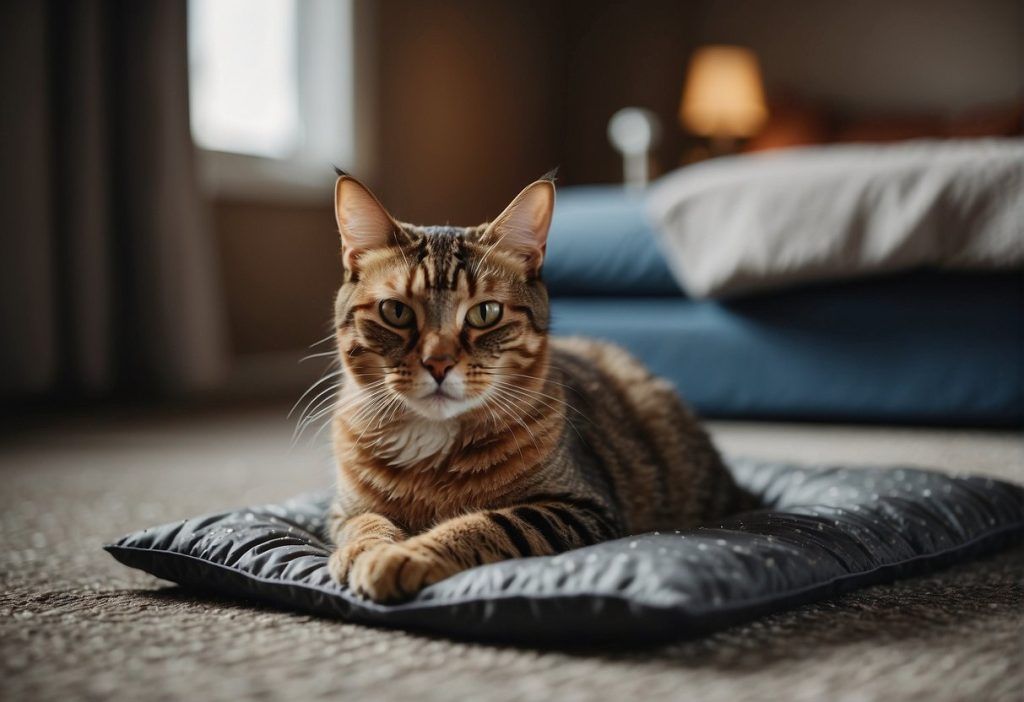
When to Consult a Veterinarian
Have you noticed your furry companion acting out of the ordinary? Here are some key signs that it might be time to consult your vet:
- Frequent accidents even though they’re litter-trained
- Visibly straining or showing discomfort when urinating
- Blood in their urine
- Expressing less interest in their normal activities
Case example: Imagine a cat owner finding their pet, previously well-behaved, repeatedly peeing on the dog’s bed.
After a vet visit, it turns out the cat has a urinary tract infection (UTI), a common culprit. Treatment begins, and the cat’s behavior improves—no more unwanted surprises on the dog’s bed!
Role of Animal Behaviorists
Unsure why your cat’s chosen the dog’s bed for their business? It could be behavioral, and that’s when an animal behaviorist steps in. (4)
Behaviorists can unravel the mystery behind the motive.
Finding and Working with a Behaviorist:
- Seek referrals from your vet or local pet owners.
- Choose someone certified—a good track record with cats is a must.
- Be ready to provide details about your cat’s environment, habits, and history.
- Collaborate on a tailored behavior modification plan.
Success Story: A cat, once a notorious dog-bed-wetter, turned a new leaf after behavior modification guided by a professional.
The cat learned to love its revamped litter box setup, and harmony was restored in the home.
Always remember, you’re not alone in this. Whether it’s medical or behavioral, help is just an appointment away!
Creating a Harmonious Multi-Pet Home
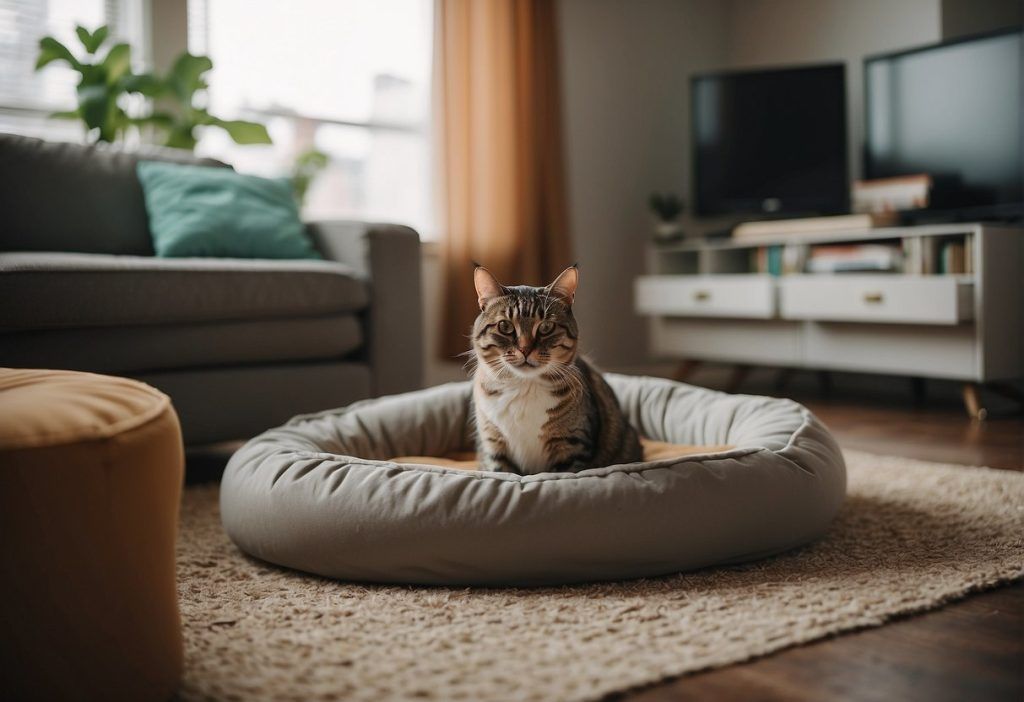
Fostering Positive Cat and Dog Relationships
The key is patience and a proper introduction. Here’s a quick guide for a smooth meet-and-greet:
- Slow and Steady:
Start with separate spaces. Switch their bedding so they can get used to each other’s scent. - Supervised Hangouts:
Keep initial face-to-face meetings short. - Comfort Zones:
Gradually let them explore each other’s area, maintaining a safe escape route.
Sounds doable, right? Let’s keep the peace!
Ensuring Individual Comfort and Safety
Want to give your cat and dog their “me-time” while living under one roof? It’s easy as pie!
- Living Spaces: Set up cozy, exclusive spots for each pet. This way, they have a retreat during “off” days.
- Reduction Technique: Keep stress levels low with toys and plenty of exercise.
- Safety First: Ensure both have access to food and water without crossing paths if they choose not to.
Remember, what works for Loulou the cat might not be ideal for Fido the dog, but a little effort can make a shared space a happy place!
Keep things fun and light to let the friendship blossom on their terms. Who says cats and dogs can’t be best buddies?
Providing high perches and introducing artificial pheromones, which mimic the calming pheromones released by cats, for your cat to feel safe and in control can also help create a harmonious multi-pet home.
Quick Recap
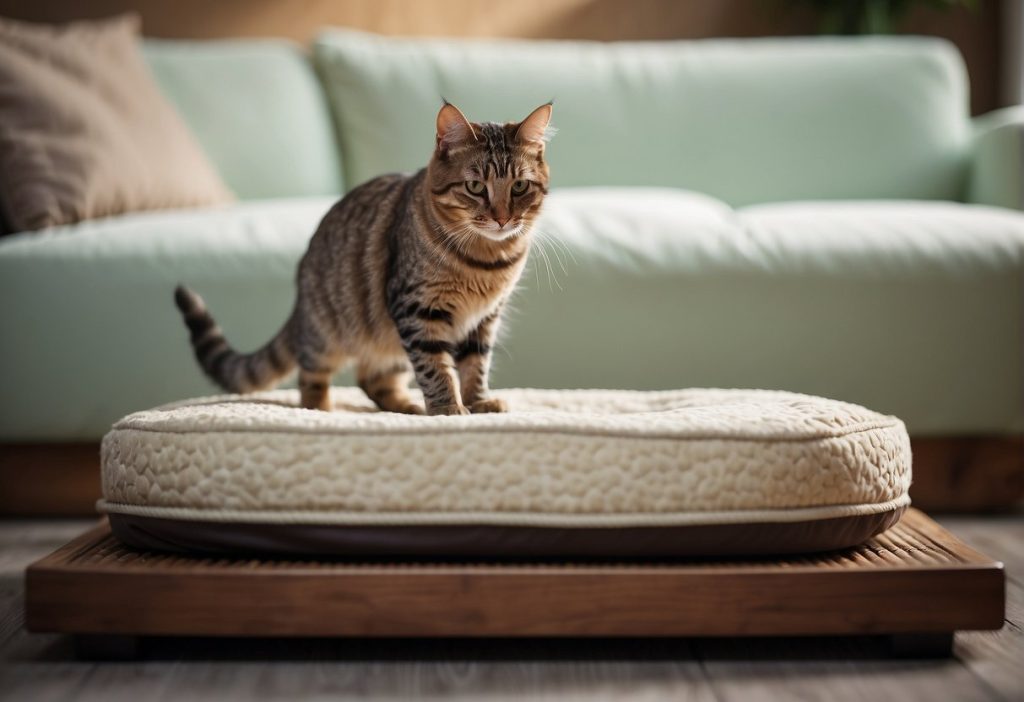
Let’s quickly run through what we’ve learned so that you can nip this problem in the bud.
Common Reasons for Inappropriate Urination:
- Medical Issues: Cats with UTIs or other discomforts may avoid the litter box.
- Territorial Marking: Your cat might be saying, “This spot is mine!”
- Stress or Anxiety: Changes at home can lead to marking behavior. (5)
- Litter Box Dislikes: From its location to the type of litter, if something’s not right, your cat may protest.
- Number of Litter Boxes: One box might not cut it, especially in multi-cat homes.
Solutions That Work:
- Veterinary Checkup: Rule out any health concerns with a quick visit to the vet.
- Cleaning Routine: Enzymatic cleaners are your best friend when it comes to erasing that pee scent.
- Positive Reinforcement: Catch them using the litter box correctly. Treat time!
- Litter Box Audit: Make sure it’s the cat’s meow — clean, well-placed, and with the preferred litter.
Here’s a table to break it down for you:
| Do Check | Do Not |
| Health of your cat | Ignore litter box issues |
| Cleanliness of the dog bed | Punish your cat |
| Number and placement of litter boxes | Use ammonia-based cleaners |
Remember, consistency and patience are key. It might take a little detective work and some trial and error, but you’ve got this!
Maintain harmony in your multi-pet household by ensuring each furry friend has its comfy territory and needs to be met.
Keep at it, and you’re sure to restore peace (and cleanliness) to your home in no time!
Frequently Asked Questions
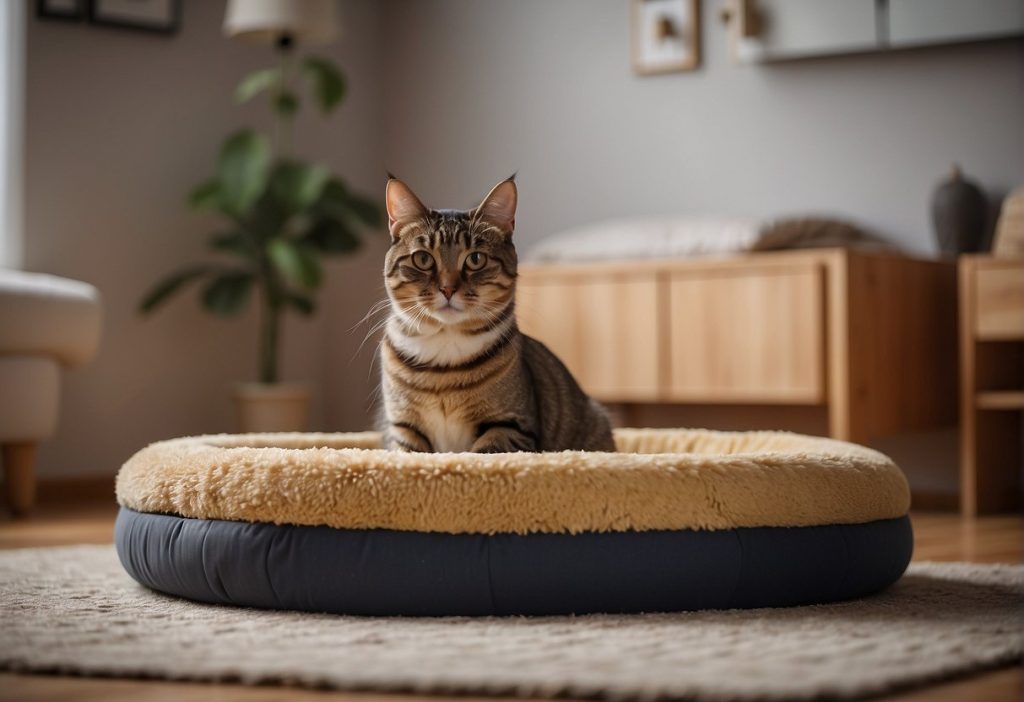
Cats peeing on dog beds can be perplexing and frustrating.
These FAQs will guide you through understanding why your cat may be doing this, and offer practical solutions to help you manage the situation effectively.
Why does my cat pee on the dog’s bed?
Your cat might be peeing on the dog’s bed due to stress, territorial marking, litter box aversion, or as a response to environmental changes.
It’s a way for them to communicate discomfort or claim space.
How can I stop my cat from peeing on the dog’s bed?
To stop your cat from peeing on the dog’s bed, ensure the litter box is clean, appealing, and properly located.
Also, provide environmental enrichment and consider adding more litter boxes in different locations.
Could my cat’s behavior indicate a medical problem?
Absolutely! If your cat suddenly starts this behavior, it could be indicative of a urinary tract infection, diabetes, or kidney disease.
It’s essential to consult your veterinarian for a proper diagnosis.
What are the best cleaning methods for a dog bed after a cat has peed on it?
Clean the dog bed thoroughly using an enzymatic cleaner to eliminate urine odors and discourage future marking.
Avoid ammonia-based products as they can attract your cat back to the spot.
How do I introduce my cat to my dog to prevent territorial issues?
Introduce them gradually, starting with scent swapping, then short supervised visits, and increasing contact as they get comfortable with each other.
This can help reduce competition and territorial behavior.
Are there specific products that can help prevent this behavior?
Yes! Products like Feliway mimic cat pheromones and help lower stress levels.
You could also use deterrent sprays on the dog bed, although it’s crucial to address the root cause of the behavior.
What role can a pet behaviorist play in resolving this issue?
A pet behaviorist can provide tailored strategies and support based on your cat’s particular situation.
They can help you understand the behavior and work out a behavior modification plan.


